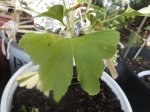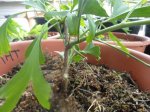KiwiPlantGuy
Omono
I guess so, was kind of thinking regarding stronger growing off the rootstock vs weaker paler growth.
See what Jerry has to say also.
See what Jerry has to say also.
I think the "week on its own roots" is a myth. From what I have read on some ginkgo propagation papers for cuttings, if you get a 50% success your doing pretty well. Your little tree has just spent all it's energy making itself a set of roots thus is very week and spends most of its second year balancing and reestablishing itself. That's why it initially is growing so slow. One reason everything is grafted is that ginkgos are easy to grow from seed and easy to graft. At 50% success rate it takes 2 cuttings to make 1 tree but each cutting has 6 buds on it. The success rate of grafting is very high and the trees I have been getting seem to be made with a scion of 2 buds, so from a propagators point of view he gets 6 trees instead of one, if he grafts instead of takes cuttings. If he is working with something he has discovered he may have very little material to work with. Loping off a sapling and grafting a couple buds on it gives a powerful root system that is trying to balance itself by making a new top out of those two little buds so it will grow like crazy with no delays like there are with the cuttings. It's ready to sell almost as soon as the graft takes. Ginkgos are 280 to 170 million year species=not week on there own roots. (or much of anything else). Any given new variety though, could have its own quarks. I know that grafting fruit trees gets crazy in spacifics and it can change tree size or fruit quality or maturing rates. I don't know the status of root stock development for ginkgo grafts. Some of mine seem to be on rooted cuttings but that might be the only choice available to to the propagator. It takes 30 years for ginkgos to mature enough to reproduce and you need both a male and female tree so rooting cuttings in mass from any ginkgo and developing the root stock from them to do the grafts might be what is sometimes done. I have a couple plants that seem to be grafted twice. Was that a failed graft re-grafted, or special circumstances? I don't know. Your turn! Tell us how you were successful on your cutting propagation. How many cuttings?, How many took? How did you do it? (Try please to be more specific than what's in most of the internet search articles that show up.) I should know in another month if mine took.I have a few questions about this amazing tree species. ( and their root system)
Ginkgo ( non- grafted) doesn't grow well on its own roots?? True or False?
If the answer to the first question is TRUE, then do I purchase a grafted dwarf cultivar ( princess?? ) for $50 and the air-layer the top. I am a bit confused. ( if it doesn't grow it's own roots that well etc ).
Also I propagated 6 inch semi - hardwood cuttings last year which did root but root system was a bit shaky for a few months after prop etc.
Looking forward to some answers please and thanks, Charles.
I have a few questions about this amazing tree species. ( and their root system)
Ginkgo ( non- grafted) doesn't grow well on its own roots?? True or False?
If the answer to the first question is TRUE, then do I purchase a grafted dwarf cultivar ( princess?? ) for $50 and the air-layer the top. I am a bit confused. ( if it doesn't grow it's own roots that well etc ).
Also I propagated 6 inch semi - hardwood cuttings last year which did root but root system was a bit shaky for a few months after prop etc.
Looking forward to some answers please and thanks, Charles.
What variety is it?Heres the one i have !
View attachment 156475
What variety is it?
You are right. Ginkgos don't backbud much, even with normal bonsai methods that are supposed to encourage it. But that is not quite what I was talking about. I am talking about turning a short bud into a long shoot. I will write a separate snipit shortly and it will be more clear but have to go for now. BTY I am not a professional nurcery man, just a farm boy that turned machinest by trade and is a somewhat well researched ginkgo crazy enthousist.Hi Jerry,
Thank you for your comments and in depth look at the cutting grown ginkgo plants. Your opinion gives me hope as I considered the cuttings to be inferior to the seedlings ( rootstock).
I have been in the nursery trade ( landscape plants and commercial cut flower production) all my career at 25 years now. I can see the commercial viability thing re propagating via grafts etc.
My tiny experience so far is taking 8 cuttings and getting 6 rooted with enough roots to pot on etc. Cuttings taken as 4-6 inch length and semi- hardwood ( after spring growth hardened etc). Oh nearly forgot, bottom heat and misting ( misting probably more important) and took about 6-8 weeks to root.
New Zealand doesn't have enough population to get loads of varieties. There's only 2 I know of. The standard one with big leaf and stretched growth habit, and a new? one I am interested in buying called 'Ming Princess'. Bit corny but has a lovely dwarf habit with 10-15 branches in its 1 meter height and 10 litre pot. ( grafted tho). No photo yet sorry.
I think your desire to get loads of back budding is honorable but maybe trying to get an apple out of an orange ( if you get my drift).
As you say tho, in 15 - 25 years time we might have something vaguely worthwhile as ginkgo bonsai. I do love the tree very much as the leaves are so unique.
Charles.
And... soon as I posted the query above, KiwiPlantGuy post showed up above my query but still not my pic or previous post.
You are right. Ginkgos don't backbud much, even with normal bonsai methods that are supposed to encourage it. But that is not quite what I was talking about. I am talking about turning a short bud into a long shoot. I will write a separate snipit shortly and it will be more clear but have to go for now. BTY I am not a professional nurcery man, just a farm boy that turned machinest by trade and is a somewhat well researched ginkgo crazy enthousist.
 Here is one of the short buds on the root stock of my Ginkgo Biloba cultivars If this bud leafs out
Here is one of the short buds on the root stock of my Ginkgo Biloba cultivars If this bud leafs out  .
.Never felt down played at all, just putting "credentials" in order, AND maybe I'm not exactly using proper official terminology. My understanding is that dorment buds are not very visible and actively growing. In the picture of 'Joeahsphat' above the short bud is the top bud on the left of the central stem. It is actively growing with lots of leaves on it. (6-8 of them. The lower stem is about 18 in long and they were both the same size (a big fat juicy bud) this spring. The short may leaf out like that many years in a row while the longer one may grow a foot every year. Neither are dormant. There was a small scale experiment done on a couple of branches (The major part of the experiment had something to do with bud developement6 I didn't really understand) defoliating slowed and stopped the long bud branches from growing -at least for the season. No mention was made as to back budding. It's worth experimenting with but I think extra N would just make the long bud grow faster with longer internodes. Also after several years the short buds which grow just a little bit every year looks kind of spur like. Note the leaf scar from last year on the long shoot. It looks like it was a short bud last year. If this doesn't help try asking more q's please. This is great discussion!Hi, I was not trying to down- play your enthusiasm, just trying to introduce myself and background.
I can offer an opinion about dormant buds, and my guess is that some parts of the tree may have different amounts/levels of hormones. Depending on how high up the trunk they are. OR as other learned comments lead me to think that many of the buds are very dormant, and not much can alter their sleepiness.
Lastly, I can say that a vigorously growing ginkgo can be defoliated to initiate back-budding but you seem to have different results.
Please explain your short bud thing as maybe a high Nitrogen feed could be enough to push it long??

